Welcome to Matrix Education
To ensure we are showing you the most relevant content, please select your location below.
Select a year to see courses
Learn online or on-campus during the term or school holidays
Learn online or on-campus during the term or school holidays
Learn online or on-campus during the term or school holidays
Learn online or on-campus during the term or school holidays
Learn online or on-campus during the term or school holidays
Learn online or on-campus during the term or school holidays
Learn online or on-campus during the term or school holidays
Get HSC Trial exam ready in just a week
Get HSC exam ready in just a week
Select a year to see available courses
Science guides to help you get ahead
Science guides to help you get ahead
Reduce your exam stress, now! Learn how to write English Exam notes to prepare you for your English exam success.

Join 75,893 students who already have a head start.
"*" indicates required fields

Join 8000+ students each term who already have a head start on their school academic journey.
Are your study notes too dense to memorise? Are you struggling to find important information in your study notes? This is why we need to have English exam notes! In this article, we will show you the different ways you can write your English exam notes to fully prepare to ace your English exams.
Too often, students rely on their study notes to study for their exams. This is problematic because they are unable to remember their notes and recall important information.
Study notes are used to revise your year’s content to you ensure that you understand everything and that you don’t miss out on any information.
Exam notes are used to memorise key pieces of information. These key points act as a trigger for you to recall more detailed information.
Write the perfect notes to ace your exams! Fill out your details below to get this resource emailed to you. "*" indicates required fields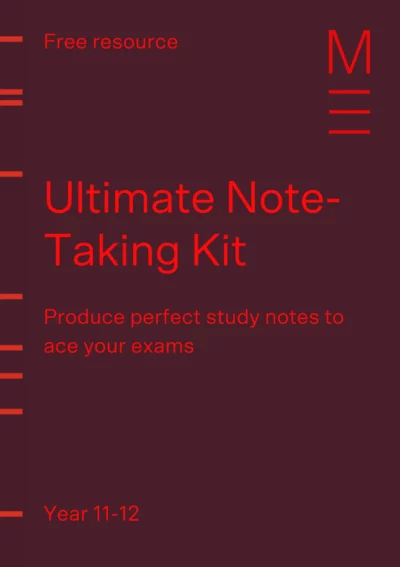
Download your FREE Ultimate Note-Taking Kit

Download your FREE Ultimate Note-Taking Kit
| Study notes | Exam notes |
|
|
Just as there are a plethora of different learning styles, there are many ways you can write and develop your English notes. What we’ll do now is show you some different step-by-step processes for compiling effective English study notes.
It is impossible to remember 15-20 different examples for every theme, for every text.
Instead, by breaking your examples down to the 3 most important pieces of evidence…
You can easily memorise and recall them when you’re writing your responses!
Additionally, by categorising your evidence into themes, you can easily recall appropriate techniques to use for your arguments.
Alright, let’s see how to do this:
Read through your study notes and highlight or asterisk important evidence per theme, per text.
Remember, one example can include multiple techniques. So, to figure out which piece evidence is strongest, you need to examine the following:
Try not to select a low order technique, like repetition or alliteration, unless they are used in conjunction with a stronger or more significant technique to create meaning.
Now that you’ve identified important evidence from your study notes, it is time to select the most important example for each theme, per text.
Rate each of the selected examples you identified above and order them from strongest to weakest.
Select your strongest 3-4 evidence per theme, per text.
These are the examples that you will prioritise memorising.
When you are compiling these pieces of evidence into your exam notes, ensure that you include:
Note: Ensure that you select some techniques that are specific to the form.
For example, if you are analysing a film, you should be analysing the shots, angles, lighting, acting, costume etc. Don’t simply focus on the metaphor or imagery used in the character’s dialogue because this is not only weak, but it is not specific to the form!
Now, it’s time to create your secondary set of evidence. These are your next 2-3 strongest examples.
A secondary set of evidence ensures that you have a variety of examples and techniques to tackle different types of questions
However, don’t stress if you can’t remember these!
You should focus on your first selection of evidence and make sure you remember those off by heart before you begin rote learning these. This is your exam security net.

Download our kit with clear step-by-step instructions and the 3 templates below for you to print and use!
[InlineContentDownloadForm]
This type of English exam notes is all about identifying connections between different themes for each text, as well as the connections between texts for each module (approach to a text. Eg, a close study, genre study, or contextual study).
Having a master mind-map, flow chart or table will help you better formulate your theses and structure your arguments.
Using this you’re able to quickly recall connections between different themes and texts and consequently, scaffold a strong essay during your exams.
Note: If you are studying multiple texts for the module (eg. comparative studies, prescribed text vs related text, 5 different poems…), you must also find connections between the texts.
So, you will probably end up with a few mind-maps, flow charts or tables for each module.
You can choose to create a mind-map, flow chart or table. Each have their own benefits and disadvantages.
So, it depends on what works with you best!
Let’s take a look at the pros and cons for these exam note forms:
| Mind-map | Flow chart | Theme table | |
| Pros |
|
|
|
| Cons |
|
|
|
By now, you should have already identified your text’s themes. So, simply make a list of these themes from your study notes.
You will be relying on this list to draw your mind-map, flow chart or table.
Now, let’s see how we can draw these these diagrams!
Developing your Mind-map
Note: You should use different colours to represent different things. This is to prevent your mind-map from becoming too messy.
So, now that you know how to draw a mind-map, let’s take a look at an example from a Matrix student:

Here, the student circled the main themes and wrote the ideas in black. They also drew connections in purple and briefly explain these connections in red.
This allows the student to easily identify different aspects without overcrowding the mind-map.
Also, notice how the mind-map is simple but also contains just the right amount of information to make sense. The student briefly identifies different ideas that derives from a theme, and relates it to other themes.
Developing a Flow-chart
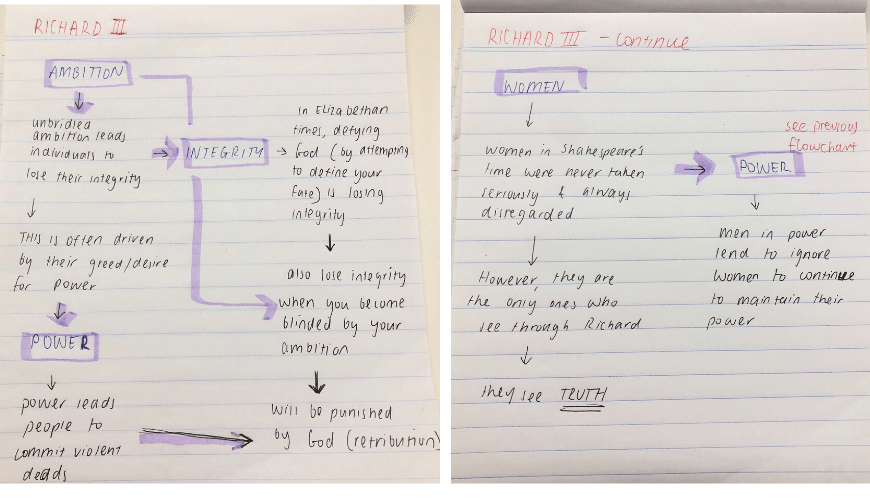
Notice how the flow chart guides you through a theme and their ideas, to another theme and their ideas. Doesn’t this seem familiar?
That’s right!
The flow chart mimics an essay structure. It shows a ‘flow of ideas’ which helps you structure cohesive and sustained essays.
Flow charts allow students to explore different ideas that stems from a theme and relate them to other ideas and themes.
Developing a theme Table
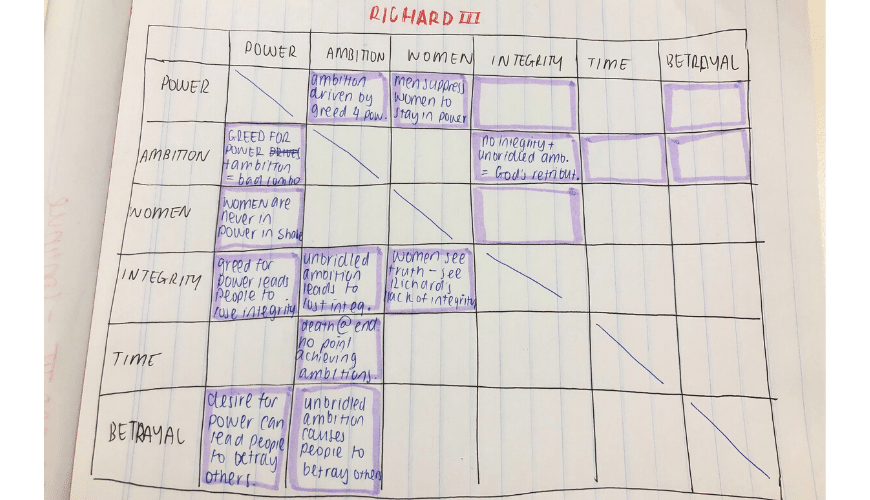
You will find that there are 2 squares for each connection between 2 themes. This gives you space to write 2 different comments on this connection.
Although it’s best to try to fill in all the highlighted squares, don’t feel obliged to do so.
How to use tables for comparative study:
Table 1: Study of 2 texts
Now, let’s see how to identify connections between a pair of texts. The best diagram for this task is a table because you are able to clearly identify shared themes between different texts.
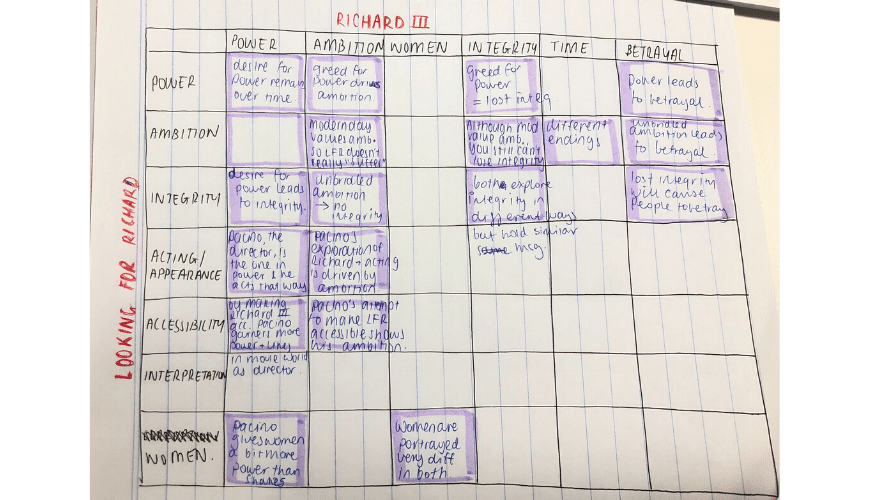
Notice how we are able to easily identify shared themes and related themes between the two texts. Memorising this table will help you figure out your thesis and arguments in your exam.
Table 2: Study of more than 2 texts
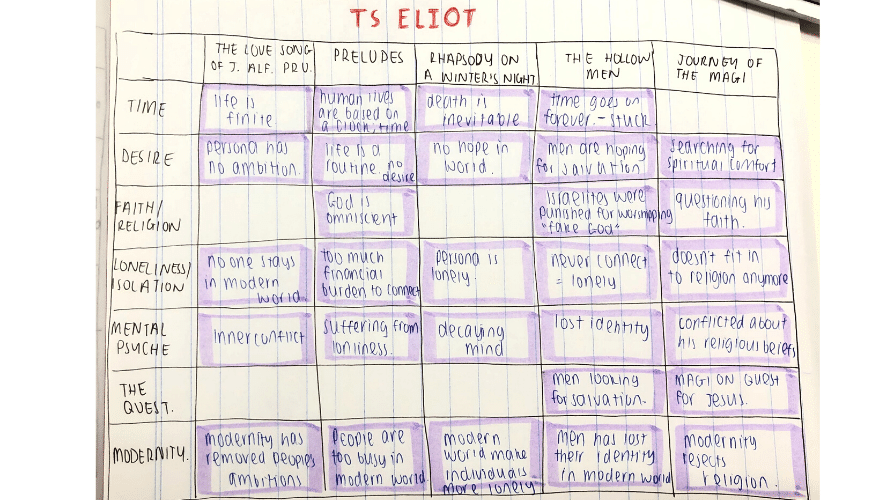
Notice how some texts may explore more common themes than others. This table is a sure way of identifying these shared themes and connections between the texts.
This is an essential study asset for “compare” or “contrast” questions!
Use these tables to figure out the most suitable texts to discuss in your essays based on your question and the themes they explore.
Scaffolds are essentially a combination of Step 1 and Step 2. A scaffold requires you to identify related themes and ideas and identify the most important questions.
They are plans for your essay structure.
A scaffold includes:
Writing scaffolds (and doing scaffolding drills -timed scaffolding drills where you produce a scaffold to a question against a time limit) will prepare you to answer a wide range of questions and help you develop the skills needed to quickly formulate strong theses and arguments.
There are many ways you can formulate and/or find questions.
Some methods are more challenging than others. You can choose to follow multiple methods or stick to one. It is up to you to figure out what is best for your studies!
a. Ask teachers for questions
You can always ask your teachers or Matrix teachers to give you a bank of good essay questions to scaffold your responses.
This way you know you are practising with strong exam-style questions.
Remember to always be polite when you are asking.
b. Find questions from past papers or online resources
Another method is looking for past papers or online resources to find questions.
This is another sure way of ensuring that you are practising a wide range of exam-style questions.
Your school should provide you with past papers. If not, search online for some past papers or question banks.
We have a few question banks and past papers for HSC English:
c. Build a bank of questions with your friends
If you are confident with your text and the structure of exam-style questions, then feel free to write your own practice questions.
Create a shared document with your friends and pop down your questions.
At the end, you will have a document of different types of exam-questions, written by different people!
This means that you will have a wide range of questions with different focuses.
d. Change your syllabus dot points into questions
This method is a sure way of ensuring that you are prepared for anything that the syllabus may require you to do. (This is a useful habit you should practise from junior years, if you can, as it will teach you the skills you need for Stage 6)
Obviously, this method does require you to spend more time formulating questions (but that will help you learn the syllabus dot-points!).
Now, the challenge! Formulate a quick thesis and dot point your arguments.
Ask ‘why’ and ‘how’ as you are answering the question to fully flesh out your thesis and arguments.
Remember, these are not supposed to be a polished piece of writing. This activity is supposed to train the way you think and approach questions.
Now, go through your study notes or list of evidence for each theme and select the most appropriate pieces of evidence for your arguments.
You can write a brief comment that explains how the evidence supports your argument.
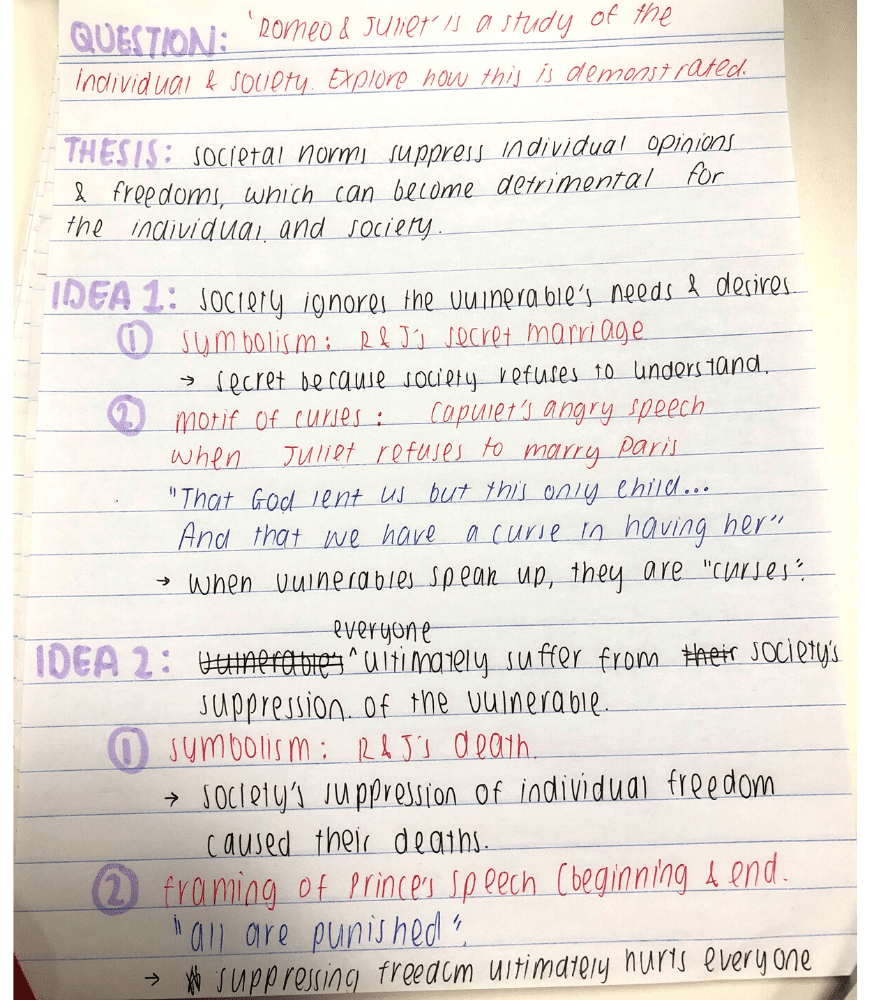
As we can see from above, the student has colour coded their work. Red is used for the question and the evidence/technique, whereas blue is used for the example. Black is used for the ideas and the brief explanation of the evidence.
You should practise doing a few scaffolds to a variety of different questions to fully prepare yourself for the exam. You don’t know what type of question the exam will throw at you, so it is best to be prepared!
Simply writing your notes and never looking back at them is not good enough. You need to also remember them!
So, here are some useful tips to help you make memorable notes:
Study from the comfort of your home with Matrix+. Learn with HSC English experts, structured Theory lessons, and Q&A boards!
Get ahead with Matrix+ online
Learn at your own pace with expert teachers and proven resources. 96% of students saw their marks improve.
Written by Matrix English Team
The Matrix English Team are tutors and teachers with a passion for English and a dedication to seeing Matrix Students achieving their academic goals.© Matrix Education and www.matrix.edu.au, 2025. Unauthorised use and/or duplication of this material without express and written permission from this site’s author and/or owner is strictly prohibited. Excerpts and links may be used, provided that full and clear credit is given to Matrix Education and www.matrix.edu.au with appropriate and specific direction to the original content.